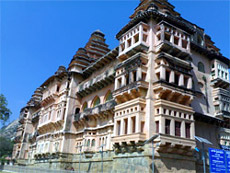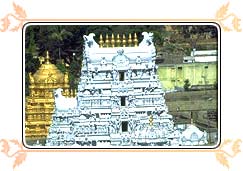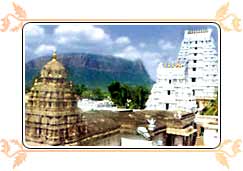Sri Venkateswara Govinda Namavali
Sri Srinivasa Govinda
Sri Venkatesa Govinda
Bhaktavatsala Govinda
Bhagavatapriya Govinda
Nityanirmala Govinda
Neelameghasyama Govinda
Puranapurusha Govinda
Pundarikaksha Govinda
Govinda Hari Govinda
Gokulanandana Govinda
Nandanandana Govinda
Navaneeta chora Govinda
Pasupalaka Sri Govinda
Papavimochana Govinda
Dushtasamhara Govinda
Durita nivarana Govinda
Sishta paripalaka Govinda
Kashta nivarana Govinda
Govinda Hari Govinda
Gokulanandana Govinda
Vajramakutadhara Govinda
Varahamurtivi Govinda
Gopijanalola Govinda
Govardhanoddhara Govinda
Dasarathanandana Govinda
Dasamukha mardhana Govinda
Pakshivahana Govinda
Pandavapriya Govinda
Govinda Hari Govinda
Gokulanandana Govinda
Matsya Kurma Govinda
Madhusudhana Hari Govinda
Varaha Narasimha Govinda
Vamana Brughurama Govinda
Balaramanuja Govinda
Bhouddha Kalkidhara Govinda
Venuganapriya Govinda
Venkataramana Govinda
Govinda Hari Govinda
Sri Venkatesa Govinda
Bhaktavatsala Govinda
Bhagavatapriya Govinda
Nityanirmala Govinda
Neelameghasyama Govinda
Puranapurusha Govinda
Pundarikaksha Govinda
Govinda Hari Govinda
Gokulanandana Govinda
Nandanandana Govinda
Navaneeta chora Govinda
Pasupalaka Sri Govinda
Papavimochana Govinda
Dushtasamhara Govinda
Durita nivarana Govinda
Sishta paripalaka Govinda
Kashta nivarana Govinda
Govinda Hari Govinda
Gokulanandana Govinda
Vajramakutadhara Govinda
Varahamurtivi Govinda
Gopijanalola Govinda
Govardhanoddhara Govinda
Dasarathanandana Govinda
Dasamukha mardhana Govinda
Pakshivahana Govinda
Pandavapriya Govinda
Govinda Hari Govinda
Gokulanandana Govinda
Matsya Kurma Govinda
Madhusudhana Hari Govinda
Varaha Narasimha Govinda
Vamana Brughurama Govinda
Balaramanuja Govinda
Bhouddha Kalkidhara Govinda
Venuganapriya Govinda
Venkataramana Govinda
Govinda Hari Govinda
*********
Virajateerastha Govinda
Virodhimardhana Govinda
Govinda Hari Govinda
Gokulanandana Govinda
Salagramadhara Govinda
Sahasranama Govinda
Lakshmivallabha Govinda
Lakshmanagraja Govinda
Kasturitilaka Govinda
Kanchanambaradhara Govinda
Garudavahana Govinda
Govinda Hari Govinda
Gokulanandana Govinda
Vanarasevita Govinda
Varadhibandhana Govinda
Edukondalavada Govinda
Ekaswarupa Govinda
Sri Rama Krishna Govinda
Raghukula nandana Govinda
Pratyakshadeva Govinda
Paramadayakara Govinda
Vajrakavachadhara Govinda
Govinda Hari Govinda
Gokulanandana Govinda
Vaijayantimala Govinda
Vaddikasulavada Govinda
Vasudevatanaya Govinda
Bilvapatrarchita Govinda
Bhikshuka samstuta Govinda
Streepumrupa Govinda
Siva Kesavamurti Govinda
Brahmandarupa Govinda
Bhaktarakshaka Govinda
Govinda Hari Govinda
Gokulanandana Govinda
Nityakalyana Govinda
Neerajanabha Govinda
Haati Ramapriya Govinda
Harisarvottama Govinda
*******
Virajateerastha Govinda
Virodhimardhana Govinda
Govinda Hari Govinda
Gokulanandana Govinda
Salagramadhara Govinda
Sahasranama Govinda
Lakshmivallabha Govinda
Lakshmanagraja Govinda
Kasturitilaka Govinda
Kanchanambaradhara Govinda
Garudavahana Govinda
Govinda Hari Govinda
Gokulanandana Govinda
Vanarasevita Govinda
Varadhibandhana Govinda
Edukondalavada Govinda
Ekaswarupa Govinda
Sri Rama Krishna Govinda
Raghukula nandana Govinda
Pratyakshadeva Govinda
Paramadayakara Govinda
Vajrakavachadhara Govinda
Govinda Hari Govinda
Gokulanandana Govinda
Vaijayantimala Govinda
Vaddikasulavada Govinda
Vasudevatanaya Govinda
Bilvapatrarchita Govinda
Bhikshuka samstuta Govinda
Streepumrupa Govinda
Siva Kesavamurti Govinda
Brahmandarupa Govinda
Bhaktarakshaka Govinda
Govinda Hari Govinda
Gokulanandana Govinda
Nityakalyana Govinda
Neerajanabha Govinda
Haati Ramapriya Govinda
Harisarvottama Govinda
*******
Gokulanandana Govinda
Sitanayaka Govinda
Sritaparipalaka Govinda
Daridrajanaposhaka Govinda
Dharmasamsthapaka Govinda
Anatha rakshaka Govinda
Aapdbhandhava Govinda
Saranagatavatsala Govinda
Karunasagara Govinda
Govinda Hari Govinda
Gokulanandana Govinda
Kamaladalaksha Govinda
Kamitaphaladata Govinda
Papavinasaka Govinda
Pahi Murare Govinda
Srimudrankita Govinda
Srivatsankita Govinda
Dharaninayaka Govinda
Dinakarateja Govinda
Govinda Hari Govinda
Gokulanandana Govinda
Padmavatipriya Govinda
Prasannamurti Govinda
Abhayahasta pradarsana Govinda
Mastyavatara Govinda
Sankachakradhara Govinda
Sarngja Gadhadara Govinda
********
Sitanayaka Govinda
Sritaparipalaka Govinda
Daridrajanaposhaka Govinda
Dharmasamsthapaka Govinda
Anatha rakshaka Govinda
Aapdbhandhava Govinda
Saranagatavatsala Govinda
Karunasagara Govinda
Govinda Hari Govinda
Gokulanandana Govinda
Kamaladalaksha Govinda
Kamitaphaladata Govinda
Papavinasaka Govinda
Pahi Murare Govinda
Srimudrankita Govinda
Srivatsankita Govinda
Dharaninayaka Govinda
Dinakarateja Govinda
Govinda Hari Govinda
Gokulanandana Govinda
Padmavatipriya Govinda
Prasannamurti Govinda
Abhayahasta pradarsana Govinda
Mastyavatara Govinda
Sankachakradhara Govinda
Sarngja Gadhadara Govinda
********
Janardhanamurti Govinda
Jagatsakshirupa Govinda
Abhishekapriya Govinda
Apannivarana Govinda
Ratnakireeta Govinda
Govinda Hari Govinda
Gokulanandana Govinda
Ramanujanuta Govinda
Swayamprakasa Govinda
Aasritapaksha Govinda
Nityasubhaprada Govinda
Nikhilalokesa Govinda
Anandarupa Govinda
Aadyantarahita Govinda
Ihaparadayaka Govinda
Ibharajarakshaka Govinda
Govinda Hari Govinda
Gokulanandana Govinda
Paramadayalo Govinda
Padmanabha Hari Govinda
Tirumalavasa Govinda
Tulasi Vanamala Govinda
Seshadrinilaya Govinda
Sirnivasa Sri Govinda
Sri Venkatesa Govinda
Govinda Hari Govinda
Gokulanandana Govinda
*********
Jagatsakshirupa Govinda
Abhishekapriya Govinda
Apannivarana Govinda
Ratnakireeta Govinda
Govinda Hari Govinda
Gokulanandana Govinda
Ramanujanuta Govinda
Swayamprakasa Govinda
Aasritapaksha Govinda
Nityasubhaprada Govinda
Nikhilalokesa Govinda
Anandarupa Govinda
Aadyantarahita Govinda
Ihaparadayaka Govinda
Ibharajarakshaka Govinda
Govinda Hari Govinda
Gokulanandana Govinda
Paramadayalo Govinda
Padmanabha Hari Govinda
Tirumalavasa Govinda
Tulasi Vanamala Govinda
Seshadrinilaya Govinda
Sirnivasa Sri Govinda
Sri Venkatesa Govinda
Govinda Hari Govinda
Gokulanandana Govinda
*********













 In the southern wing of the mandapam, is a statue of Venkatapathi Raya of the Aravidu dynasty, who ruled over Chandragiri around 1570 AD. To the side are stone statues of Achyutha Raya and his wife Varadajiamma. This mandapam was built during the later Vijayanagara rule. It is filled with beautiful pictures of the Vijayanagara period. Vaishnava symbols or the Urdhvapundras flanked by a conch and disc are carved at the top of the two main pillars of the mandapam. The Ranga Mandapam is also called the Ranganayakula Mandapam and is located in the southeastern corner of the Sampangi Pradakshinam. The shrine is where the utsava murti of Lord Ranganadha of Srirangam was kept during the 14th century, when Muslim rulers occupied Srirangam. The Yadava ruler Sri Ranganadha Yadava Raya constructed it in Vijayanagar style between 1320 and 1360 AD.
In the southern wing of the mandapam, is a statue of Venkatapathi Raya of the Aravidu dynasty, who ruled over Chandragiri around 1570 AD. To the side are stone statues of Achyutha Raya and his wife Varadajiamma. This mandapam was built during the later Vijayanagara rule. It is filled with beautiful pictures of the Vijayanagara period. Vaishnava symbols or the Urdhvapundras flanked by a conch and disc are carved at the top of the two main pillars of the mandapam. The Ranga Mandapam is also called the Ranganayakula Mandapam and is located in the southeastern corner of the Sampangi Pradakshinam. The shrine is where the utsava murti of Lord Ranganadha of Srirangam was kept during the 14th century, when Muslim rulers occupied Srirangam. The Yadava ruler Sri Ranganadha Yadava Raya constructed it in Vijayanagar style between 1320 and 1360 AD.  The Aina Mahal is on the northern side of the Tirumala Raya Mandapam and consists of two parts - an open mandapam in the front consisting of six rows comprising six pillars each, and a shrine behind it consisting of an Antarala and Garbhagriha. It has large mirrors, which reflect images. There is an unjal in the middle of the room where the Lord is seated and festivals are conducted. The Dhwajasthambha Mandapam houses the Dhwajastambha (a wooden flagpole encased in gold) and the Bali Peetha (seat for food offering). A peculiar feature of the Mandapam is that it is covered (unlike in other temples) to facilitate the conduct of rituals in all weather conditions. The relative positions of the Dhwajasthambha and the Bali Peetha are in accordance with Vaikhanasa Agamic traditions.
The Aina Mahal is on the northern side of the Tirumala Raya Mandapam and consists of two parts - an open mandapam in the front consisting of six rows comprising six pillars each, and a shrine behind it consisting of an Antarala and Garbhagriha. It has large mirrors, which reflect images. There is an unjal in the middle of the room where the Lord is seated and festivals are conducted. The Dhwajasthambha Mandapam houses the Dhwajastambha (a wooden flagpole encased in gold) and the Bali Peetha (seat for food offering). A peculiar feature of the Mandapam is that it is covered (unlike in other temples) to facilitate the conduct of rituals in all weather conditions. The relative positions of the Dhwajasthambha and the Bali Peetha are in accordance with Vaikhanasa Agamic traditions.  The Potu or main kitchen where the food-offerings for the main temple are prepared is to the south of the Varadarajaswami shrine. Inside the Potu is a small shrine dedicated to Lakshmi and she is also called Potu Amma (lady of the kitchen) or Madapuli Nachiyar. She is acknowledged as Vakulamalika, who according to the Puranas was sent by Varahaswami to be the housekeeper of Sri Venkateswara, when he resided on the hill. She is also said to have arranged Lord Venkateswara`s marriage with Padmavathi. She is Lakshmi, and is worshipped so during Varalakshmi Vratam, in the month of Sravana. An icon of Lakshmi can be seen at Padi Potu, another kitchen is located in the Sampangi Pradakshinam. The rice prasadam is prepared in the inner Potu, while other laddus, vadas appams etc., are prepared in the Padi potu.
The Potu or main kitchen where the food-offerings for the main temple are prepared is to the south of the Varadarajaswami shrine. Inside the Potu is a small shrine dedicated to Lakshmi and she is also called Potu Amma (lady of the kitchen) or Madapuli Nachiyar. She is acknowledged as Vakulamalika, who according to the Puranas was sent by Varahaswami to be the housekeeper of Sri Venkateswara, when he resided on the hill. She is also said to have arranged Lord Venkateswara`s marriage with Padmavathi. She is Lakshmi, and is worshipped so during Varalakshmi Vratam, in the month of Sravana. An icon of Lakshmi can be seen at Padi Potu, another kitchen is located in the Sampangi Pradakshinam. The rice prasadam is prepared in the inner Potu, while other laddus, vadas appams etc., are prepared in the Padi potu.  The main shrine includes the sanctum and three consecutive halls in front right up till Bangaru Vakili. These are the Snapana Mandapam - a square hall, Ramar Meda - a rectangular hall, and Sayana Mandapam - also rectangular in shape, where the Ekanta Seva is performed. Adjacent to the porch of Bhashyakara Sannidhi on the west side is a small room called Talapakamara or Sankeertana Bhandara. It was constructed to preserve the collection of sankeertanas composed by the Talapaka poets - Talapaka Annamacharya, his son Pedda Tirumalacharya and grandson Chinna Tirumalacharya, who were the minstrels attached to the temple. In front of the Potu is a well called Bangaru Bavi. The site as mentioned in the Vaikhanasa Agamas was constructed according to Vijayanagara style.
The main shrine includes the sanctum and three consecutive halls in front right up till Bangaru Vakili. These are the Snapana Mandapam - a square hall, Ramar Meda - a rectangular hall, and Sayana Mandapam - also rectangular in shape, where the Ekanta Seva is performed. Adjacent to the porch of Bhashyakara Sannidhi on the west side is a small room called Talapakamara or Sankeertana Bhandara. It was constructed to preserve the collection of sankeertanas composed by the Talapaka poets - Talapaka Annamacharya, his son Pedda Tirumalacharya and grandson Chinna Tirumalacharya, who were the minstrels attached to the temple. In front of the Potu is a well called Bangaru Bavi. The site as mentioned in the Vaikhanasa Agamas was constructed according to Vijayanagara style.  The Snapana Mandapam is also called the Tiruvilan kovil. It has four central pillars, with the sculptures of Bala Krishna, Yoga Narasimha and Kaliayamardhana. One such impressive sculpture is that of Vishnu seated with four arms - the upper arms hold the chakra and the shankha. The Lord`s consorts are seated in Sukh asana on either side. Ramar Meda, is an elevated platform for Rama housed the icons of Rama, Sita and Laxmana, but has been moved to the sanctum. Utsava Murthis of Vishvaksena and Garuda have their own shrines.
The Snapana Mandapam is also called the Tiruvilan kovil. It has four central pillars, with the sculptures of Bala Krishna, Yoga Narasimha and Kaliayamardhana. One such impressive sculpture is that of Vishnu seated with four arms - the upper arms hold the chakra and the shankha. The Lord`s consorts are seated in Sukh asana on either side. Ramar Meda, is an elevated platform for Rama housed the icons of Rama, Sita and Laxmana, but has been moved to the sanctum. Utsava Murthis of Vishvaksena and Garuda have their own shrines.  The Sayana Mandapam, also called the Ardha Mandapam, is directly in front of the sanctum. This is as close as the pilgrims can get to the inner sanctum. The mandapam is connected to the sanctum by a gate called kulasekhara-padi named after an Alwar saint who wished to be reborn as the threshold to the Lord`s shrine. This mandapam is used to perform rituals that cannot take place in the sanctum. The garbha griha or sanctum is where the main idol of Lord Sri Venkateswara resides. Sanctum is where the idol of the Lord stands. In between the sanctum and the Sayana Mandapam, is the threshold called the Kulasekhara-padi. The idol stands directly beneath the gilt dome called Ananda Nilaya Divya Vimana. Pilgrims are not allowed to enter the garbha griha.
The Sayana Mandapam, also called the Ardha Mandapam, is directly in front of the sanctum. This is as close as the pilgrims can get to the inner sanctum. The mandapam is connected to the sanctum by a gate called kulasekhara-padi named after an Alwar saint who wished to be reborn as the threshold to the Lord`s shrine. This mandapam is used to perform rituals that cannot take place in the sanctum. The garbha griha or sanctum is where the main idol of Lord Sri Venkateswara resides. Sanctum is where the idol of the Lord stands. In between the sanctum and the Sayana Mandapam, is the threshold called the Kulasekhara-padi. The idol stands directly beneath the gilt dome called Ananda Nilaya Divya Vimana. Pilgrims are not allowed to enter the garbha griha.  The kalyanotsavam or marriage festival is celebrated in the Kalyana Mandapam. It is similar to the Tirumala Raya Mandapam. To the west is a small mandapam carried on slender cut-stone pillars and surmounted by a vimana. To the south is the Yagasala where yagyas related to Brahmotsavam and other festivals are performed. Close to the Sangeeta Bhandara in the northern corridor of the Vimana Pradakshinam is the shrine of Sri Ramanuja and is also called the Bhashyakara Sannidhi. Ramanuja was the architect of Tirupati and the father of the Sri Vaishnava community here.
The kalyanotsavam or marriage festival is celebrated in the Kalyana Mandapam. It is similar to the Tirumala Raya Mandapam. To the west is a small mandapam carried on slender cut-stone pillars and surmounted by a vimana. To the south is the Yagasala where yagyas related to Brahmotsavam and other festivals are performed. Close to the Sangeeta Bhandara in the northern corridor of the Vimana Pradakshinam is the shrine of Sri Ramanuja and is also called the Bhashyakara Sannidhi. Ramanuja was the architect of Tirupati and the father of the Sri Vaishnava community here.  Sri Narasimhaswami shrine is located to the left of the Ramanuja shrine and hold an idol of Sri Yoga Narasimha. Built in the 15th century, it is surrounded by a polished mandapam. Dance poses are sculptured on the pillars. Yoga Narasimhaswami is also known as Girija Narasimhaswami. He is seated with his hands on his knees, and girdled by the Yogapatta. A ceremonial bath (Tiru-Manjana) is given to the idol in the sanctum on Saturdays; and on the fourteenth day of the bright half of the month of Vaisakha (according to the lunar calendar) Swati Nakshathram the idol is specially worshipped on account of Narasimha Jayanti.
Sri Narasimhaswami shrine is located to the left of the Ramanuja shrine and hold an idol of Sri Yoga Narasimha. Built in the 15th century, it is surrounded by a polished mandapam. Dance poses are sculptured on the pillars. Yoga Narasimhaswami is also known as Girija Narasimhaswami. He is seated with his hands on his knees, and girdled by the Yogapatta. A ceremonial bath (Tiru-Manjana) is given to the idol in the sanctum on Saturdays; and on the fourteenth day of the bright half of the month of Vaisakha (according to the lunar calendar) Swati Nakshathram the idol is specially worshipped on account of Narasimha Jayanti.  On the eastern side of the mandapam is a small shrine dedicated to Garuda. On the north side is a gangala or large brass vessel covered with a fabric, for depositing all votive offerings. From the Tirumamani you can enter the Bangaru Vakili to reach the inner sanctum. There are two tall copper images of the dwarapalakas Jaya and Vijaya on either side of the door. The thick wooden door is covered with gilt plates depicting the dasavataram of Vishnu. The doorway is in direct line with the Padi Kavali and the Vendi Vakili and it admits pilgrims to the Snapana Mandapam. The Suprabhatam is sung in front of this door.
On the eastern side of the mandapam is a small shrine dedicated to Garuda. On the north side is a gangala or large brass vessel covered with a fabric, for depositing all votive offerings. From the Tirumamani you can enter the Bangaru Vakili to reach the inner sanctum. There are two tall copper images of the dwarapalakas Jaya and Vijaya on either side of the door. The thick wooden door is covered with gilt plates depicting the dasavataram of Vishnu. The doorway is in direct line with the Padi Kavali and the Vendi Vakili and it admits pilgrims to the Snapana Mandapam. The Suprabhatam is sung in front of this door. 








 The temple of Sri Venkateswara has acquired unique sanctity in Indian religious lore. The Sastras, Puranas, Sthala Mahatyams and Alwar hymns unequivocally declare that, in the Kali Yuga, one can attain mukti, only by worshipping Venkata Nayaka or Sri Venkateswara.
The temple of Sri Venkateswara has acquired unique sanctity in Indian religious lore. The Sastras, Puranas, Sthala Mahatyams and Alwar hymns unequivocally declare that, in the Kali Yuga, one can attain mukti, only by worshipping Venkata Nayaka or Sri Venkateswara.  The Aina Mahal
The Aina Mahal
